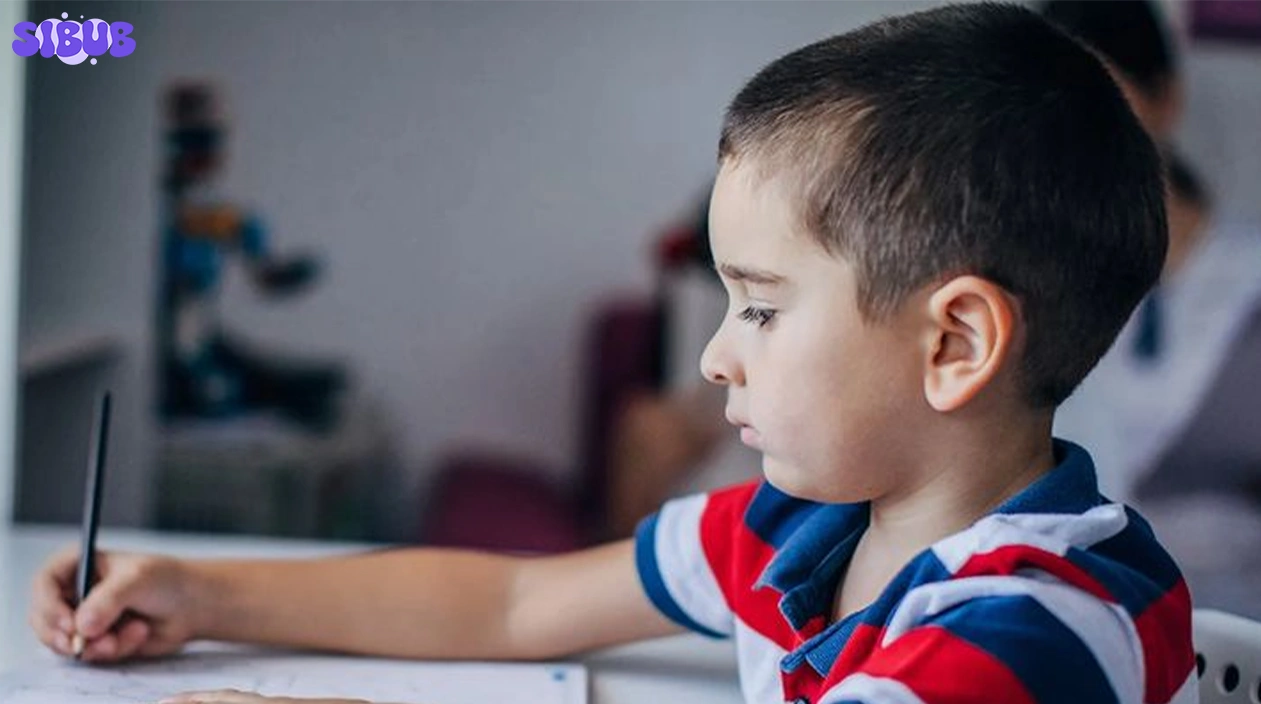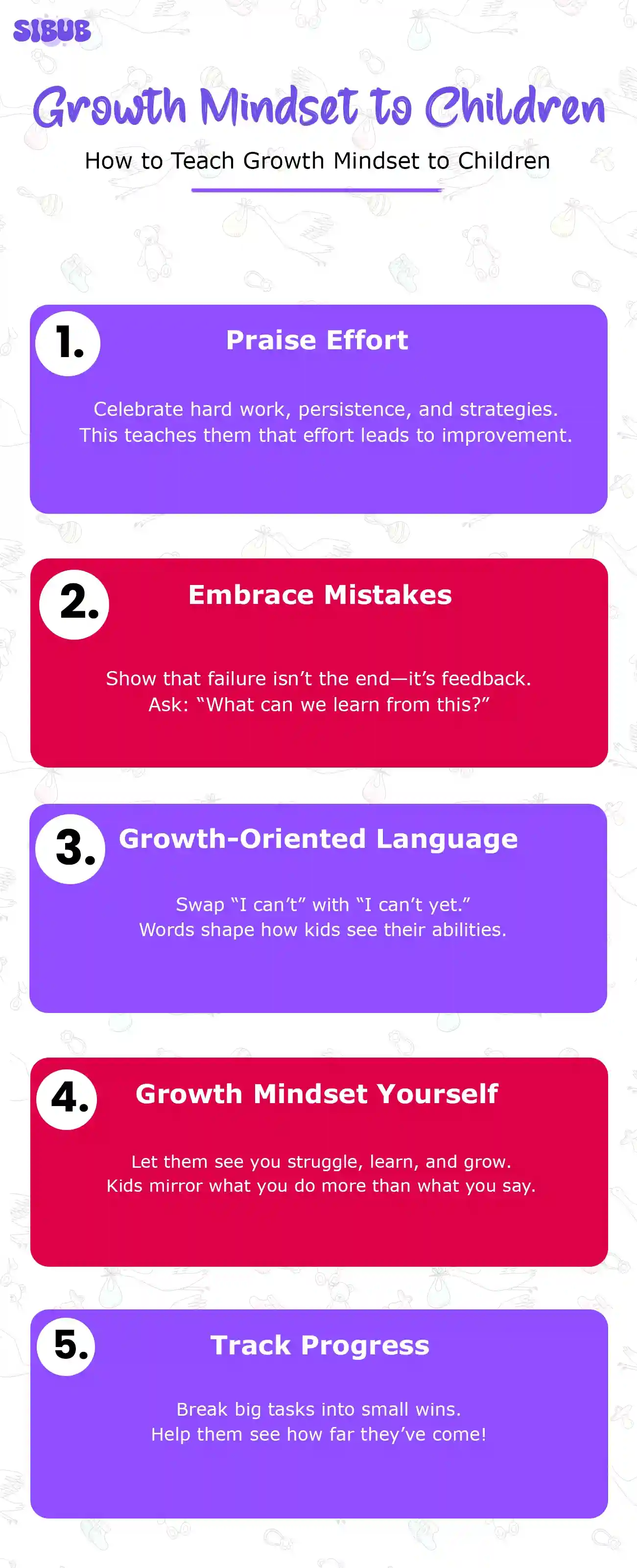“Whether you think you can or think you can’t, you’re right.” – Henry Ford
Your child’s test results are not satisfactory. Does your child think, ‘I’m just not clever enough,’ or ‘What can I do to perform better next time?’ That split second says a lot about them.
Fostering and teaching a growth mindset for kids helps them develop skills to manage failure, effort, and success. Aside from self-feedback, a growth mindset serves as a scaffolding for all challenges of life. The best part? It can be taught.
Let’s discuss how you can instill a growth mindset in your child from as early as preschool.
What Is Growth Mindset for Kids?
Before teaching it, let’s break down the growth mindset definition for kids:
A growth mindset is the belief that skills and mental capacities can be cultivated through effort, learning, and determination. It stems from a fixed mindset that assumes that talents and intelligence are set in stone.

Discover: Nurturing Healthy Kids, Guiding Confident Parents
In simpler terms: “If I try hard, I’ll improve.”
This concept, brought to us by psychologist Carol Dweck, shaped children’s understanding of the brain like a muscle—it will get stronger the more it is used.
The Difference Between Growth Mindset and Fixed Mindset
Learners who display a fixed mindset avoid challenges, exhibit rapid withdrawal, and possess an overly cautious attitude towards failure. Conversely, a growth-minded child embraces learning and demonstrates resilience alongside perseverance when facing difficulties.
Stanford University indicates that students with a growth mindset academically outperform their peers. This is particularly at pivotal points, such as during the onset of middle school.
When Should One Start Teaching It
The soonest possible age. In fact, a preschooler’s thoughts on life already contain beliefs regarding capability.
Example: A 4-year-old saying, “I can’t draw,” can be encouraged to add the word “yet.”
At any point in time, your child is shaping beliefs about themselves. Providing growth mindset instruction early helps encourage them to restrain themselves from self-defeating tendencies.
Explore: Top Benefits of Summer Camp for Kids
How To Encourage a Growth Mindset in Your Child
Here are ways you can help your child on a daily basis:
Praise the Process and Not the Person
Instead of complimenting a child by saying, “You are so smart,” go for “I saw how hard you worked on that.”
This change rewards focus and praise towards effort and strategy rather than perpetuity towards personality attributes. Eventually, your child learns how to cope and associate success with congruent action.
Accept the Struggle
Make a point to openly discuss your mistakes. Rather, show them that failing is a part of learning.
Example: “I burned dinner tonight because I was rushing. I need to work on my planning.”
This approach reframes focus towards failures as actionable feedback rather than a gaping black hole for flaws.
Encourage Growth Mindset Language
Saying simple phrases can change people’s mindset, and in the case of a growth mindset for kids, try using:
- “Mistakes are learning opportunities.”
- “What can you try differently next time?”
- “You don’t know it… yet.”
These target statements develop an inner spirit that fights for small efforts.
Illustrate Lifelong Learning
Encourage your child to observe you as you try something new, whether it is cooking, learning an app, or step-by-step problem solving.
When parents practice growth and learning, children adopt it too.
Foster a Growth-Friendly Environment
Envelop your child with books, growth mindset visuals, and stories celebrating persistence. Posters, bound journals, and storybooks bring these concepts to life.

Learn More: Emotions Wheel for Kids: Benefits and How to Use
Teaching Growth Mindset Lessons By Age
Let’s focus on teaching these concepts in an age-appropriate manner.
Preschool (Ages 3-5)
Aim: Primary emphasis on emotional regulation and descriptive vocabulary.
- Read picture books with characters who grow/change through effort.
- Use “It’s okay to try again” frequently.
- Use play as a way to practice perseverance (puzzles, building blocks, crafts).
Elementary Students (Ages 6-11)
Aim: Focus on skills building, school mindset, and peer dynamics.
For younger students, teaching a growth mindset at the elementary level can include:
- Journals and anchor charts for lessons.
- Group projects require collaboration and problem-solving.
- Time for self-reflection: “What did I learn from that?”
Teens (11-13)
Aim: Focus on identity, confidence, and social comparison.
- Allow goal-setting and progress tracking.
- Talk about brain science: “Your brain gets stronger when you put in effort.”
- Encourage self-evaluation after setbacks.
Resources and Exercises that Promote a Growth Mindset
Let’s examine what the activities listed above set out to achieve before listing tools. These activities aim to make fun and tangible the concepts underpinning the growth mindset.
Vivid Growth Mindset Aids
- Exhibit a trademark poster or Power of ‘Yet’.
- Exhibit brain-building cartoon like Mojo from ClassDojo.
- Engage in coloring sessions with positive self-affirmation statements.
Journals and Self-Reflection
- Establish a “mistake of the week” journal.
- Employ “One thing I didn’t give up on this week was…” prompts.
Role Playing and Situational Analysis
- Act out narrative roles with challenging tasks and characters.
- Analyze what a fixed mindset vs. a growth mindset answer would sound like

Discussing Notable Myths
Some people think that having a growth mindset for kids means talent is disregarded. That is false.
Everyone has their unique skill set, but mindset is what makes all the difference.
Another myth: “Growth mindset is only for the classroom.” This is not the case. It is applicable to athletics, personal relationships, and even day-to-day decisions.
Reiterate that this is about effort, strategy, and learning—not everyone magically becomes identical.
View more Growth & Development Blogs.
Recap and Conclusions
Instilling a growth mindset in kids is a matter of integrating it into the family culture and requires continuous attention, not just a single lesson.
Utilize simplifying approaches: emphasize efforts, reinforce learning, talk about the brain, use visuals, and have consistent phrases.
Note that their academic performance will improve, but what is even more important is that they will become a confident, flexible learner for life.
